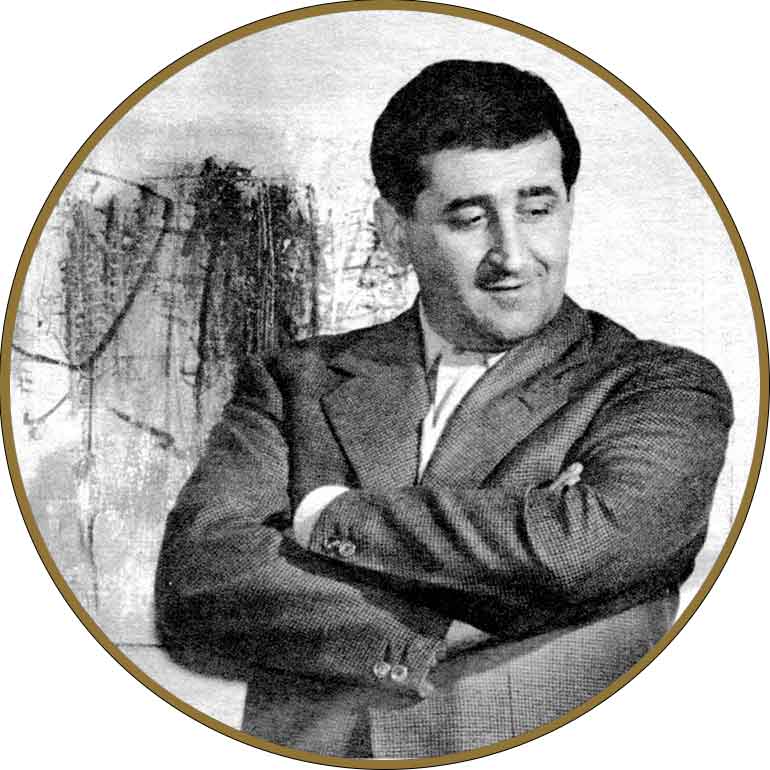Emilio Scanavino biography

Emilio Scanavino, born in Genoa in 1922, was a painter and Italian sculptor of great importance in international contemporary art. His life and artistic path were characterized by a profound cultural duality, influenced both by his father's theosophy and his mother's fervent Catholic faith, the latter element contributing to shaping the inner conflict reflected in the artist's artworks. From the early years, Emilio Scanavino showed a marked artistic aptitude and his passion for art led him to enroll at the Nicolò Barabino Artistic High School in Genoa in 1938, where he had the opportunity to meet Professor Mario Calonghi, a figure of considerable stimulus for his initial training.
In 1942, he exhibited his first artworks, characterized by landscapes and humble subjects, at the Roman Salon in Genoa, marking the beginning of his artistic career. In 1947, a trip to Paris marked a crucial moment in his stylistic evolution. During his Parisian stay, he met poets and artists, including Édouard Jaguer, Wols and Camille Bryen. The suggestions of Parisian postcubism merged with the lessons of Picasso and contemporary abstract experiences, giving rise to a personal style that would characterize his subsequent production.
Emilio Scanavino's artistic research further developed during the 1950s, culminating in artworks where the "knot" becomes the protagonist, a stylized sign that gives life to rhythmic stories and evocative atmospheres. His painting became an expression of interiority with all its torments, conveying a sense of suspension in time and presences evoked in the shadow of the studio or in the nature of Calice Ligure, where the artist would later move his atelier.
The meeting with the art dealer Carlo Cardazzo in 1952 represented an important step for the artist's career, consolidating his role in international contemporary art and opening doors to new exhibition opportunities. Moreover, the friendship and working relationship with the dealer allowed the artist to experiment and further explore the dialogue between painting, sculpture, and ceramics. Participation in the Venice Biennales and important awards helped consolidate Scanavino's fame both in Italy and abroad.
In 1963, however, a tragedy deeply affected Emilio Scanavino: the sudden death of Carlo Cardazzo, his friend and supporter. Despite this loss, the art dealer's work was carried on by his brother, Renato Cardazzo, who contributed to increasing the artist's notoriety.
In the following years, Emilio Scanavino's artistic research moved towards a simplification of the sign, with geometric forms and grids anticipating a reflection on the objectification of painting. During this period, the artist settled in his house in Calice Ligure, where other artists also settled, forming a small creative community around him.
In 1971, together with the sculptor Alik Cavaliere, he created the artwork-installation "Homage to Latin America" on the occasion of the São Paulo Biennial in Brazil. The artwork, composed of painted panels with inserts of bronze, silver, and aluminum sculptures, was censored for its political content and later exhibited at the Museo della Permanente in Milan after a restoration in 2003.
His artistic production throughout the 1970s was characterized by an ever greater simplification of the sign, culminating in artworks with grids and geometric architectures. His painting continued to evolve, witnessing a constant search and intense exhibition activity both in Italy and abroad. Emilio Scanavino's artistic career ended in 1986 with his death in Milan. His artistic legacy and his ability to express human interiority with his distinctive "knot" sign remain today as testimony of an eclectic and highly significant artist in the 20th-century art scene. His artwork, difficult to place in a specific movement, developed between informal abstraction, abstract expressionism, and the artistic research of figures like Hans Hartung and Georges Mathieu, leaving an indelible mark in art history.



